I had several students in my class that were really struggling with letter sounds. I needed to help them master this important kindergarten goal that can be overwhelming for some students in a fun and kindergarten friendly way that would motivate them.

As teachers we want to make the most of our time and interactions with our students. This letter sound lap book was created to help those students who are struggling with letter sounds, while doing so in an easy, efficient way for you at the same time. It is highly interactive and packed with opportunities for your students to practice their letter sounds in small attainable goals. Since students
who are struggling often have trouble learning all of the letters at a
time, they are broken down into smaller attainable goals.
For this, I created 5 different levels
on the spinners. For each level, there is a group of 5-6 letters to make a more manageable goal for
students. I have included an editable
version in case your curriculum may have a different order. Since students who are struggling often need lots of repetition. These spinners often repeated practice to the
students.
As an activity, students can spin the spinner (a
paperclip) and identify the letter that they land on. I also included a recording paper for this so
they have practice writing it as well.
This makes for great independent practice for the student and students follow up with you and say the letter sounds that they wrote. This recording sheet is a great piece to take home so parents can see what they are working on.
Once a
students is able to identify all of the letters on their current level, then they are
able to move on to the next level (group of 5 letters).
Also included are student flash
cards. Students can flip through these
quickly to review the letters they know and those they are working on. Once again, since they have smaller goals, in
the “Letters I Am Practicing,” you may want to include the 5 or 6 letters from
the spinner since those letters will be their focus. Students an keep their letters sorted in the pockets by letters
they know, letters they are practicing and letters they still have to learn.
By combining the letters they are practicing and letters they know, it allows students to feel successful and not overwhelmed by having 26 letters, many of which they may not know.
Another great warm up or opportunity for the
students to practice is the alphabet mini books that fit perfectly into one of the little pockets.
Students “read through” these little books and may be at a level where they just repeat the letters or some can do it independently.
For my little routine, students point and say the letter name (the capital letter), the sound (the lowercase letter underneath it), the picture and then repeat the sounds 3 time.
I put all letters in my book mini book but
another idea is to only do several mini books of the 5-6 letters they are
working on and they can warm up with only those letters.
Students can also
use the letter game board that is glued on the back to track letters they have learned and have fun practicing the letters. (This game board is included as a freebie at the end)
Students can color in the letters as they
master them. This is great to do this documentation monthly and students can use a different color each month (this is a great way for you to see as well if
they are making adequate progress and documentation for you as well).
Students can also use this game board to
practice letter sounds. For example, students can say the letter sound and they can find
matches to the flashcards they are learning.
You can also do this without the flashcards and you (or a peer) can say a letter sound and have the students find that
sound and put a chip on it. Once they
know most of their letter sounds they can roll a dice and say the sound that
they land on or do this with a friend if they aren’t quite independent and repeat
the sounds.
You can grab the letter sound game board freebie here:























